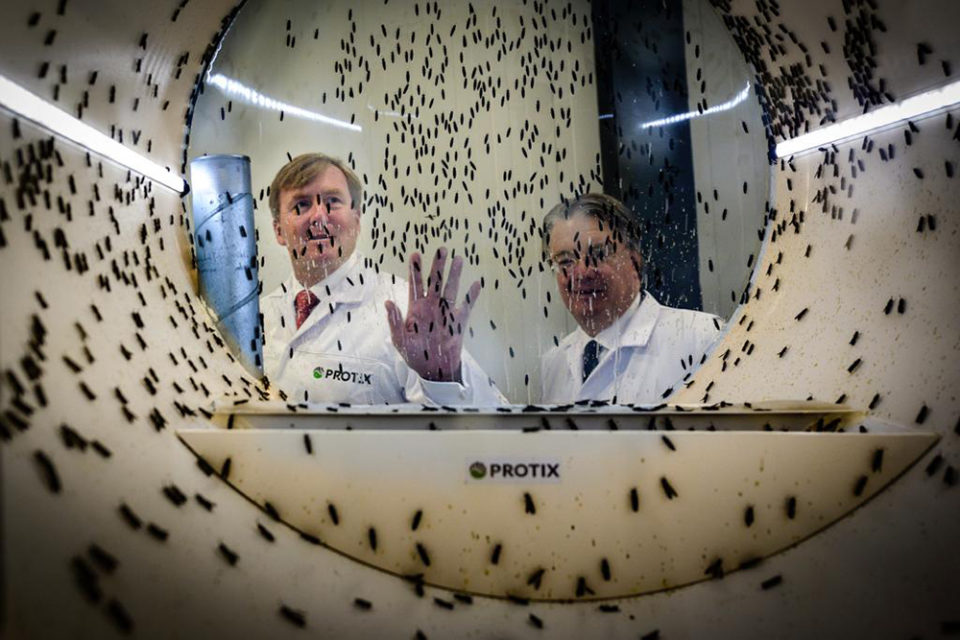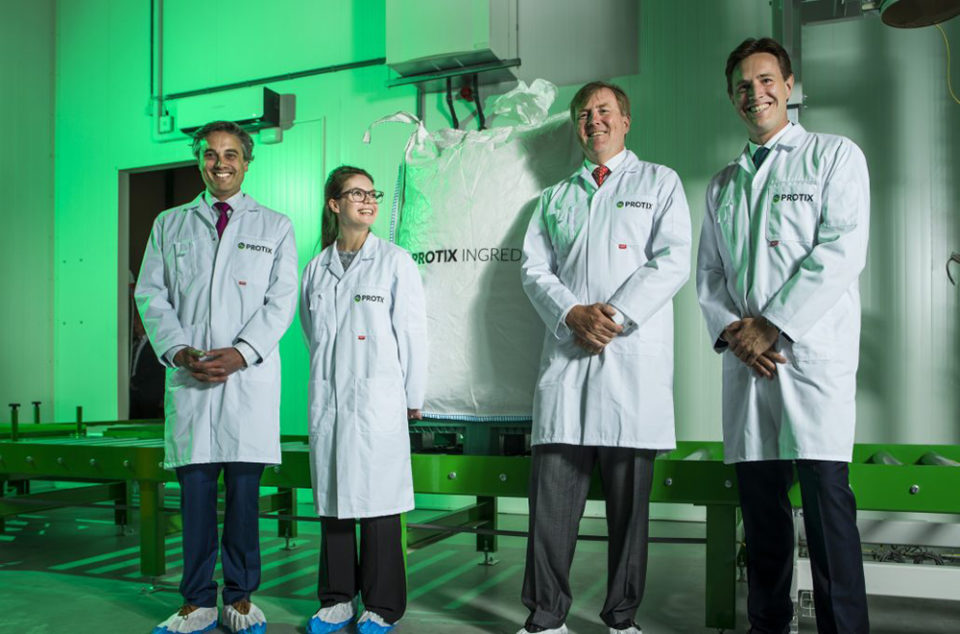Rabobank Corporate Investments’ backing of Protix could signal a new level of success in the search for sustainable protein sources for aquaculture

When it comes to making a “good” investment, you might look to sink your savings into lucrative technology titans – think Facebook, Apple and Microsoft – or jump on initial public offerings (IPOs) for high-flying digital disruptors like Uber, Lyft or Airbnb.
Pretty soon, Wall Street might start chasing a different (albeit less sexy) investment opportunity: insect meal manufacturers. In 2020, Rabobank Corporate Investments (RCI) – the investment franchise of the Dutch multinational banking and financial services company – made an undisclosed investment in Protix, a breeder of black soldier fly (BSF) larvae for sustainable animal feed production. The Netherlands-based company breeds BSF larvae and processes them into meal and oils for fish feed and livestock, and also produces fertilizer from their waste. For investors like RCI, this latest cash injection made good financial sense.
“As a large investor in food and agriculture and sustainability propositions, Rabo Corporate Investments is continuously looking for promising companies that offer solutions for today’s challenges,” said Arjan van der Hout, associate director at RCI.
“In Protix, we see a company that tackles two of the largest issues we face today: How do we sustainably produce enough food for a fast-growing global population and how do we reduce food waste throughout the supply chain? Within a new and pioneering industry, it is key to back the right party. After extensive research into the competitive field, we chose to back Protix – which we consider an absolute frontrunner, capable of meeting the challenges of this pioneering industry.”
It’s not the first investment that Protix has seen since it was first founded in 2009. In June 2017, the company received €45 million ($50.5 million) in funding from Rabobank, Aqua-Spark and other investors. The RCI investment comes on the heels of the Protix opening the world’s largest insect factory in Bergen op Zoom, in southern Holland, at a cost of €40 million ($45 million).
“Protix had met several key milestones – most importantly with the successful opening of the world’s first industrial-scale, largely automated production facility for insect ingredients,” said van der Hout. “We considered it an opportune moment to once again join with an equity investment, this time via Rabobank’s captive investment arm, Rabo Corporate Investments.”
Protix announced it March that it intends on using this injection of capital to scale up the production of insects in the Netherlands and expedite its international expansion. It’s a win for the company – but also the aquaculture industry as a whole, explains Dr. Kevin Fitzsimmons, Department of Environmental Science at the University of Arizona.
“Ramping up production levels and maintaining quality controls in the BSF meal are the last critical steps to widespread adoption of BSF as a key ingredient in aquaculture feeds,” said Fitzsimmons. “The demand for high-quality protein ingredients is rapidly growing in the aquaculture and poultry industries. Aquaculture in general is willing to pay more for these proteins than the poultry people, and still, virtually every sector of aquaculture identifies high feed costs as a key barrier to further growth. As economies of scale are achieved and costs of BSF meal production are decreased, the potential is virtually unlimited for BSF meal to replace fishmeal and even compete with soy and other plant-based proteins.”
https://www.aquaculturealliance.org/advocate/fly-guys-canada-opens-the-door-for-insect-based-feed-companies/
‘Exactly what we need’
Indeed, insects like the BSF could offer one solution to the persistent problem faced by the aquaculture industry: the need to boost production to meet the growing global demand for protein. In the global seafood picture, fish farms provide approximately 50 percent of the world’s edible seafood supply and are expected to have a 60 percent share within the next decade or so. The health and growth of many farmed fish species depend on the availability of fishmeal and fish oil, but these have fluctuating costs and sustainability issues.
Aquaculture, always on the lookout for sustainable feed ingredients to prevent production and growth from bottlenecking, has explored everything from algae to camelina oil, with black soldier flies emerging as a prime candidate for numerous reasons.
“BSF meal addresses several of the sustainability concerns that face the aquaculture industry,” said Fitzsimmons. “First, BSF meal has most of the same amino acids that are present in fishmeal, so with just a couple of complementary ingredients fish and shrimp can receive all the necessary nutrients that are in fishmeal. Second, the primary ingredients in BSF feeds are agricultural and restaurant waste materials that otherwise would end up in landfills.
“In addition, we have discovered that feeding the BSF larvae a diet enriched with seafood processing wastes will pump up their omega-3 content – exactly what we need to replace fish oil in aquafeeds. Third, the adult flies die shortly after mating and egg-laying and during that stage have no mouth or any kind of stinger. So even an accidental release of adults would have virtually no environmental impact.”
But given that commercial-scale production remains a challenge, why would investors sink sizable funds into what some may consider questionable technology? Investors like Aqua-Spark and RCI dismiss such skepticism, arguing that “the technology has proven to be able to go to the next step.”
“[Protix has] proven their technology in two different production facilities already,” said Tom Prins, head of dealflow at Aqua-Spark. “Version one and version two, which got new technology implemented, proving key production perimeters that make it ready to scale right now in that given facility and replicate those plants all over the world to get costs down. That makes it incredibly scalable.
“We have made a number of very informed investment decisions regarding Protix. We believe in what the company is doing based on all the information that we’ve seen – [which] a lot of people who might be skeptical have not seen.”
Likewise, Fitzsimmons questions industry cynics – even suggesting such doubts may be driven by industry competition.
“The quotes of ‘questionable technology’ and ‘scalability challenges’ have mostly come from the fishmeal industry,” Fitzsimmons said. “They recognize that BSF meal is a disruptive technology and mortal danger to their business model.”

Closing the cycle
Scalability debates aside, how do investors decide where to funnel funds given the abundance of “insect start-ups”? Selecting front-runners involves extensive research before making the final call on an investment decision. For instance, a company’s partnerships can be one consideration.
Protix is collaborating with a genetics company and with feed formulators, explained Beyhan de Jong, senior specialist-seafood at RaboResearch Food & Agribusiness.
“Protix stands out with its commercial partnerships with agro-industry leaders regarding genetics, rearing and processing, shared developments in feed formulation with feed companies, and creating high-value niches,” she said. “These partnerships are all ensuring the growth, or that once they reach scale, they will also have markets. We need to know that product has a market later on. It’s always good to know who is also investing – especially if any investor that comes with a food and agriculture background, for instance.”
In making investment decisions, RCI also evaluates the marketability of a product. In Protix’s case, one deciding factor that ticked this box was its ability to upcycle.
“Using organic residual streams as feed for insects, which are in turn used as a high-quality food source for fish, chickens and other animals, Protix closes the food cycle,” said van der Hout. “This circular nature of food production, coupled with the significantly smaller environmental footprint of insects versus other animals, makes the insect proposition so compelling.”
Currently, EU legislation allows certain insect proteins to be used in aquafeed and pet food ingredients, but such use for the poultry industry is limited. According to de Jong, only living larvae can be used to feed chickens, but, with mounting pressure from the “insect lobby,” she expects that EU regulations will soon allow for the critters to be fed to other livestock, thereby broadening the product’s market prospects.
“Protix is currently working hard to increase production in its first state-of-the-art facility in the Netherlands, while preparing for its further expansion at home and abroad. Full ramp-up is expected to be completed in a few months,” said van der Hout. “As production increases, Protix develops and expands its commercial relations with off-takers in various sectors, including pet food, animal feed and feed for aquaculture.”
Filling the gap
When scouting for investment opportunities, Aqua-Spark not only looks for highly profitable companies with a “well-rounded” proof of concept.
“That means they have a finished product, [and] they’ve proven their product. They’ve proven their technology, their service, and they’ve been able to sell it,” said Prins. “So they’ve been able to generate traction in the market space and create revenues on their core products. That’s when a company is typically raising funding to scale further – and that’s where we typically come in as a Series A investor.”
With investments made in some in the world’s biggest insect players, investors and scientists are optimistic, believing that BSF meal will soon become a bigger factor in the global aquafeed supply picture.
“Virtually all of the major aquafeed producers have already tested BSF meal and announced their willingness to purchase significant amounts to incorporate into their diet formulations,” said Fitzsimmons. “Protix and other BSF meal producers have had major investments recently and are all racing to ramp up production to meet the stated demand. With the interruptions in supply of fishmeal caused by coronavirus outbreaks on fishing vessels and processing plants, I expect that BSF meal will be able to step into the gap even sooner than many expected.”
Editor’s note: This article was revised on Tuesday, July 21, to better address current EU regulations for insect and insect protein usage in aquaculture and livestock feeds.
Follow the Advocate on Twitter @GAA_Advocate
Now that you've finished reading the article ...
… we hope you’ll consider supporting our mission to document the evolution of the global aquaculture industry and share our vast network of contributors’ expansive knowledge every week.
By becoming a Global Seafood Alliance member, you’re ensuring that all of the pre-competitive work we do through member benefits, resources and events can continue. Individual membership costs just $50 a year. GSA individual and corporate members receive complimentary access to a series of GOAL virtual events beginning in April. Join now.
Not a GSA member? Join us.
Author
-

Lisa Jackson
Lisa Jackson is a writer based in Hamilton, Canada, who covers a range of food and environmental issues. Her work has been featured in Al Jazeera News, The Globe & Mail and The Toronto Star.
Related Posts

Aquafeeds
Buggin’ out: Tapping the potential of insect meal in aquaculture
Black soldier flies are gaining interest as a leading alternative ingredient in aquafeeds. But will the “ick” factor be a turn-off? Advocate contributor Clare Leschin-Hoar investigates.

Aquafeeds
Fly guys: Canada opens the door for insect-based feed companies
The sci-fi flick “The Fly” warned about mixing flies and technology, but high-tech black soldier fly farmers are seizing a real opportunity in aquaculture.

Aquafeeds
Montana firm putting barley on the alternative feed ingredient menu
Aquafeed manufacturers around the world seeking alternatives to fishmeal may soon be able to turn to an abundant and underutilized crop: barley.

Aquafeeds
Mexican startup offers DIY aquafeed solution by upcycling wastewater
MicroTERRA is a promising Mexico-based startup developing systems that use microalgae to turn fishpond wastewater into protein for fish feed.

